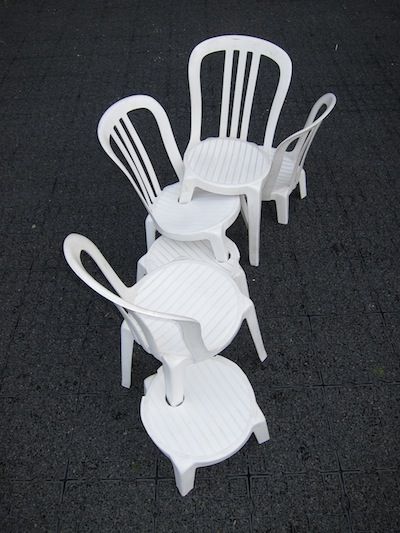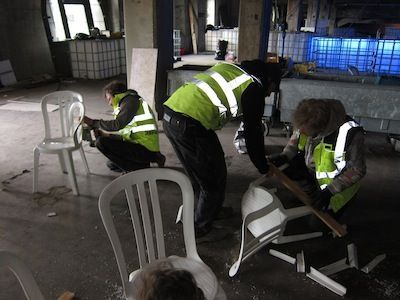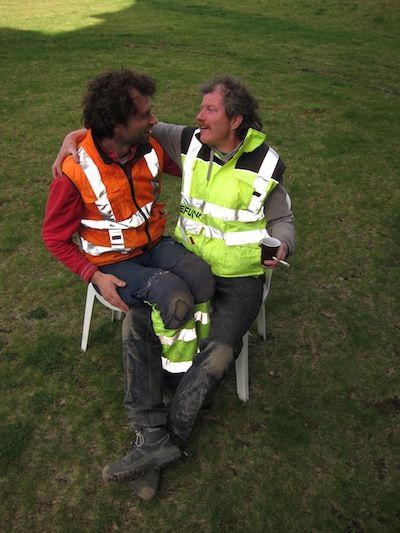NO-CHAIR-DESIGN: Happy Birthday Stefan Lindfors
Acclaimed designer Stefan Lindfors threw his birthday party at the Helsinki, White Hall. Lindfors is undoubtedly the best known designer in Finland and has caused a stir with his controversial design and public statements. In the framework of “design terrorism” Lindfors has branched outside the role of a mere industrial designer and has worked with performance art and directed short movies.. While he was greeting guests at the door something very different was being performed behind his back.

Lindforses colleague and friend artist Pekka Niskanen decided to give the birthday boy (who has designed everything from adult toys-to-buildings) something intangible. Niskanen gave the man who has designed it all.. An “invisible chair performance” as a gift. Talk about less is more design philosophy! A performance a gift is a novel idea. Special thanks to the birthday party planning team for finding the time to fit this into the tight schedule! I hope that this will serve as a good example for people interested in investing to performance art. Sometimes the act of giving is best served by giving an act.

This gift was only topped by Lindforses gift to himself.. Turning 50 he quit smoking. Congratulations mr. Lindfors!

When it comes to sustainable design Lindfors caused a scene some years back when designing the “Plup” bottled water container. Soon after he was attacked by environmentalists left-to-right. The issue was that the round (and as musician Ville Valo described “erotic and quirky“) container did not meet the returnable bottle industry standards. Hense Plups where deemed non-returnable to shops, by Palpa the "Finnish Returnable Container Company”. So, unlike with standard bottles which you get 20cents per bottle when returning to the shop (which are then grinned to shreds and remade into new bottles), people where stuck with their round and quirky Plup flasks.
10cents from every Plup sold was redirected for environmental organizations working to protect the Gulf Finland. But environmentalists argued that consumers purchasing Plup bottles where doing more harm then good. I think that at the time the product was misunderstood. As Lindfors himself stated the bottles where not meant to be recycled.. They where meant to be owned. To be refilled and reused indefinitely.
Bottled water is undoubtedly the most ridiculous commodity you can consume in a country like Finland, with fresh water running trough every tap. Lindfors made a strong statement with the Plup.. It was not about the water at all. It was only about the design. People could buy a design object for 2,50€ and use it indefinitely. It is design which places design markets in an awkward position. If every product out there would be made form the same ideological mindset.. The market value of design as a collectable would drop and consumers would soon have nothing to consume (The only thing left to invest in would be performance art..). As a statement Plup made a mockery of the bottled water industry in general.. For a while it made selling water in small bottles seem like a dump idea.

If someone out there still has a Plup in use please let the world now about it! I guess it was the marketing which caused Plups to flunk. Not to say Lindfors and friends didn’t try. Here is a video backed up with top of the line dancer (now singer) Jorma Uotinen and jackass Bam Margera.
NO-CHAIR-DESIGN: De-chairification of Weiss & Fischli
NO-CHAIR-DESIGN: Economic Chaos Illustrated With Chairs
EDIT: Jussi posted this post to the Manifesta 9 Facebook wall and it was liked! This is as close as it gets!

Here is a link send by Finnish curator Jussi (One of the person responsible the all so funny Transsexual, Bareback, Lesbian, Chairs Remix video). Jussi’s link guided me to a prototype chair “PLASTIK FANTASTIK” (2012) by REFUNC which is to presented at Manifesta 9.


REFUNC is a group which “..operates on the borders of architecture, art and design and creates new products from old materials” and Manifesta 9 call it’s self “the only itinerant european biennial of contemporary art...”.
In making representations of the “PLASTIK FANTASTIK” the REFUNC crew has used workers as models sitting on their chair.
I hope those are the artist dressed in their working uniforms. The elderly man has “REFUNC” written on his working jacked. For the NCD-Campaign we have also used “the contemporary worker uniforms” in our invisible chair representations.

Our reason for showing the invisible chair with a worker sitting on it was to: Illustrate that the economic crisis is forcing workers to “sit on thin air”, or that the workers have had “their chairs pulled from underneath them”. Investments and retirement funds are being destroyed by the global banking crisis. If the worker where to look down and notice that there is no chair, he would fall on his ass. And yes, it’s me in the photo and Jesse is behind the camera.
On their website REFUNC gives a description for their artwork. It’s stated to be an “adaptation of PVC garden chairs model ‘succes’ to social network arrangements”. I don’t understand this well. There is a typo in the description and it feels like a fast translation.
Judging from at the pictures it’s apparent that the artwork acts as a statement: The maneuvers and steps taken to fix the economic crisis are mostly effecting the working classes. That workers are forced to live in tight corners and their space is being reorganized by top-down-design.

The current economic chaos illustrated with chairs. The logic is the same as in an artists decision to use chairs as actors in a horror story – This leaves more room for the imagination. Image of a person sitting on thin air was also used in YLE – TV news when talking about the housing crisis of Spain. And as a final proof here there is this:

A Coronation Chair used for Miss Finland competitions is being auctioned. It is owned by the first commercial broadcasting company in Finland. The depression is forcing the commercial broadcasting companies to fund their business by selling iconic furniture. Oh the irony of it all…
The chair where the asses of the most beautiful women of Finland have rested is being sold to pay for the salaries of the TV staff.
An other group working with economics, attending Manifesta 9 is the Estonian Visible Solutions LLC which seems to mimic a business entity of a sort. Their own site is currently down (http://http//www.visiblesolutions.eu). Wonder if it’s a statement? It appears that mock-up companies like Ore.e Ref. are growing popular. But so far it seems that only a few of these artist run companies are really attempting to live trough their business.
NO-CHAIR-DESIGN: News from the Swingers Club for Mature Chairs.

Ore.e Ref. and Turntable joined ranks to promote urban farming and sustainable design in mid Pasila, Finland. On a cold weekend some 12 persons attended the “Swingers Club for Mature Chairs” – workshop during which people where guided how to fix worn chairs and some basic handicraft techniques like chiseling and sawing. The group succeeded in building seven tables, ten benches and some five Adirondack Chairs. The design of the Adirondack Chairs was based on models used in Chair-bombing actions (initiated by do-tank-brooklyn) in NY. The workshop was hosted at a greenhouse build by Dodo ry’s, Kääntöpöytä crew. The greenhouse opened for audiences this weekend.

Turntable, the urban farming center of Helsinki is run by Dodo and they have begun to convert the old railway infrastructure of Pasila into an active community driven urban farming test lab. Alongside farming experiments and upcoming gardening workshops, the place has a cafeteria which opens in a couple of weeks. It will serve vegetarian dishes made from food farmed in the Pasila district. Like Prinzessinnengärten in Berlin. The “Swingers Club..” workshop was initiated, produced and co-run by Turntable active, designer-artist Päivi Raivio and aided by other members of the Turntable team. Special thanks to Kirmo for feeding the workers.

Ore.e Ref’s, NO-CHAIR-DESIGN Challenge team (Which in this case means me, as Jesse was at a class reunion in Turku) was invited to run the practical part of the workshop:
- To teach people how to repair stuff and expand awareness on crafts.
- To teach how to use power-tools and special tools (like dozuki saws and planers)
- To give some insight on wood as material (joinery)
- To oversee that people didn’t get hurt when using circular saws..
The tasks the attendees where engaged in where pretty complicated for starters. Some where compiling stuff using big screws for the first time and others had their first go at chiseling. I’m happy to say that the workshop succeeded in it’s targets. People had a fun time (despite the +3 Celsius temperatures on the first day) and learned something practical.


The furniture we made during the week-end is intended to become the infrastructure of upcoming cafeteria. People tagged the benches, tables and chairs they made with their names. When they visit the cafeteria they will have the possibility to dine using furniture they made them selfs! Like with the tactical urbanism movement of Chair-bombing this was a process of building a community – by re-imagining and modifying salvaged pieces of city infrastructure. Junk wood was converted into permanent furniture with labor and these objects are likely to have a positive effect on the local community. There are designer studios, indoor pétanque arenas, festivity spaces for rent etc. in the same premises as the Turntable Urban Farming Center. Unlike with graffiti – which is simply beautiful, furniture like this is useful and hence acceptable for very different kinds of audiences. The boys at the pétanque arena already showed interest spending some time at the table.


As the furniture is tagged by their makers; they will possibly be treated more respectably and fixed autonomously by the community if they happen to break. Identifying the makers protects the objects from vandalism. Sustainable design logic.. Also the bench design is beautiful which will ultimately help it to last longer. People enjoy maintaining beautiful stuff. The design was copied from an old bench found on the site. This also gives the furniture an interesting story. It’s areal design – Possibly the beginning of a Pasila spesfic style of woodworking. The tables mimic the same look and structural solutions. The doors used as table tops where found at a nearby renovation site.



All of the wood was junk wood collected by Kääntöpöytä crew from nearby construction sites.. The wood was dirty, wet and partly rotten (used as support when making concrete structures) and people possibly didn’t get the best idea on how to really work with wood. Chiseling dry wood is much more accurate the chipping junks of wet wood. There are surely some maintenance tasks ahead once the wood dries and the screws start popping out. The wood for the benches was dried for a month in advance but the table legs where as wet as.. well as wet wood can be. Possibly the most rewarding part of the workshop was teaching people how to use power-tools like angle grinders, jigsaws and hand-held circular saws. People seemed empowered after finding the courage to use these tools.


The event was also interesting as it was an operation where a project (TURNTABLE) supported by the World Design Capital Helsinki venture and a project supported by Alternative Design Capital group (NO-CHAIR-DESIGN) where working side-by-side in hopes of transforming the city to a jollier space.
Thank you very much for attending and please come again!
A community is needed to run a farm and a farm to run a community – To eat they need a big table.

Do you recognize the designer on the left? Well if you have been following up on the NO-CHAIR-DESIGN Campaign you ought to! And the girl on the right? She’s in the game! And below here is me boasting about after a full work weekend.

Last photo by: Kirmo Kivelä / dodo.org



